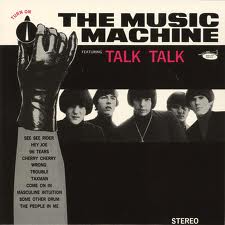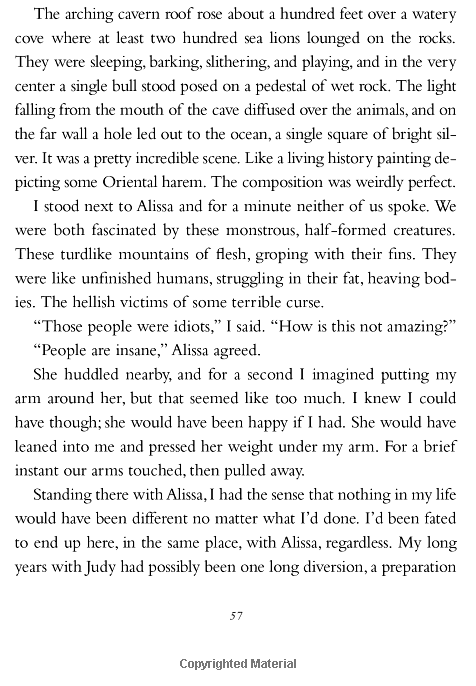Hallucinations, a blog about writing, trains, and Wire to Wire
Viewing Entries From: October 2012
Say What?
At my Wordstock workshop next weekend, one thing we’ll talk about is sniper dialogue—that short burst of speech in the middle of narrative that manages to totally redefine a particular moment or scene.
Writing good sniper dialogue is tough—for me, anyway—because you can’t rely on the back-and-forth interplay between characters. Everything depends on one line, or two, and then it’s back to narrative.
Since you have to do a lot with a little, there’s a tendency to overdo it. But it’s the underplayed dialogue that often works best in that situation.
One example I always think of is from Jon Raymond’s short story “Coast.”
A screenshot from "Coast" by Jon Raymond.
Three bursts of dialogue—four words, five words, three words—and the relationship between these two characters has changed.
I don’t know if I’ve ever written any really good sniper dialogue—when my characters start talking, they tend to keep talking—but I’m always on the lookout for it.
I’ll be talking about all kinds of dialogue at Wordstock in PDX on Saturday, October 14. The workshop I’m leading is called “Keep Talking.” Now that I see it in the program, though, I kinda wished I’d called it “Say What??” Regardless, there’s sign-up info and more details here.
______________________________
_____________________________
“Tyrants and kings do their usual things and you try to stay out of their way.” Listen to the sniper attack of electric guitar that animates the acoustic background of Seger’s “Won’t Stop.”
Seger: “I'm using a lot of acoustic guitar and then saving the electric stuff for these real razor solos, kind of like sneak attack songs." May 14, 1998, The Oakland Press
Quote Unquote
What do you do with a character who won’t say anything on the page? Or one who won’t shut up? I’m running a workshop on dialogue at the Wordstock Festival in PDX in a week or so. By then, I hope to find the answers to these and other questions.
I had both extremes in Wire to Wire—a character who wouldn’t speak unless you poked him with a stick and one who blabbed on for pages. The one who wouldn’t shut up was a lot more fun to write.
To get ready for the workshop, I’m making a list of things I want to address. Here’s what’s on it so far:
- Dialogue as character poetry
Characters who don’t talk
Characters who talk too much
Dialogue as story information – exceptions where it works
How many people in a scene can talk?
Found dialogue
Real vs. real-sounding vs. clever dialogue
Importance of the cut-away
Sniper dialogue
Extended dialogue
Situations where no one should talk
Story clues in dialogue
Dialogue attributions
Delillo dialogue/McCarthy dialogue
Dialogue quirks
Swearing in dialogue
Memorable dialogue
Your dialogue
Sometime in the next ten days, I’ll get an outline together to make sense of all that. With examples from Robert Stone, Bonnie Jo Campbell, Jon Raymond, Jonathan Franzen, Jonathan Lethem and maybe other people named John as well.
The workshop is on Saturday, October 13 at 4:30. It’ll be fun and maybe even helpful. You can sign up here.
_____________________
One minute and fifty-six seconds of garage rock that will never die: The Music Machine’s “Talk Talk.” Sean Bonniwell R.I.P.

Recent Posts
Archives
- December, 2017
- December, 2015
- January, 2015
- November, 2014
- April, 2014
- March, 2014
- December, 2013
- September, 2013
- July, 2013
- March, 2013
- January, 2013
- November, 2012
- October, 2012
- July, 2012
- May, 2012
- March, 2012
- February, 2012
- December, 2011
- November, 2011
- October, 2011
- September, 2011
- August, 2011
- July, 2011
- June, 2011
- May, 2011
- April, 2011
- March, 2011
- February, 2011
- January, 2011
- December, 2010
- ,
Categories
Links
- My Essay on Bloom: No Other Way Out
- Playlist in LargeHearted Boy
- A Book Brahmin Essay for Shelf Awareness
- Powell's Blog: Sex & Money
- Powell's Blog: Riding Freights
- Powell's Blog: Burning Down the House
- Powell's Blog: Bob Seger
- Powell's Blog: Thank You
- An Interview with Kathleen Alcala
- An interview with Laura Stanfill
- Video with Yuvi Zalkow
- Interview with Noah Dundas
- Tin House Blog: Motor City Fiction
- Blog on Occupy Writers
- W2W Essay for Northwest Book Lovers
- W2W Essay for Poets & Writers
- America Reads: Page 69
- America Reads: My book, the movie
- America Reads: What I'm Reading
- Interview with Be Portland
- The Oregonian: Where I Write


 Subscribe to the RSS feed
Subscribe to the RSS feed